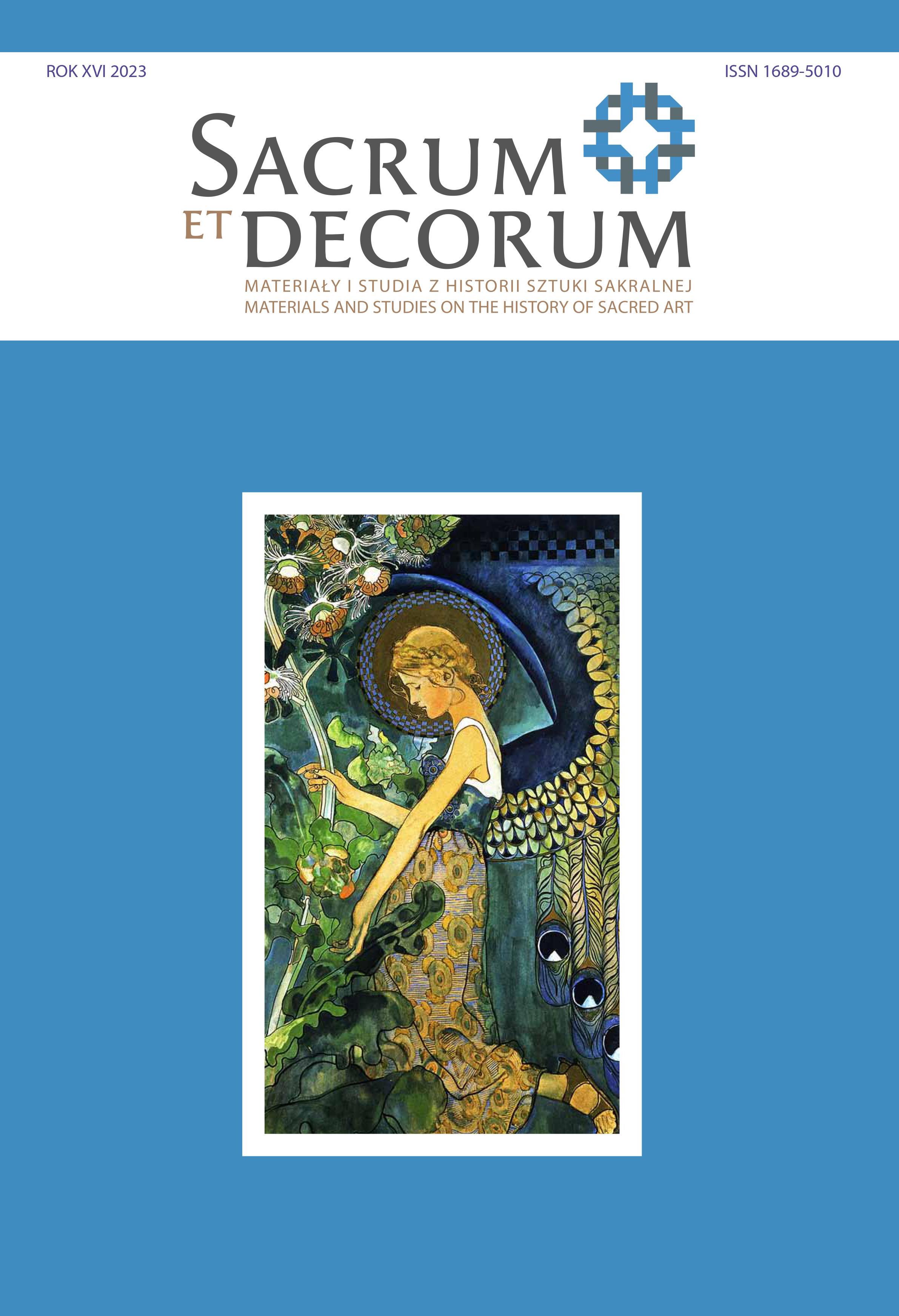Magdalena Schmidt-Góra’s Christological installations. Analysis of selected examples
DOI:
https://doi.org/10.15584/setde.2023.16.5Keywords:
Magdalena Schmidt-Góra, Janina Stefanowicz-Schmidt, Maciej Góra, Zygmunt Schmidt, Christological art installations, temporary art, modern sculpture, art in religious spaces, The Paschal Triduum, Schola Węgajty, semiology, semeion, media semantics and phenomenology, Krzysztof Niedałtowski, Pro Arte Sacra, Tomasz Misztal, Zdzisław Pidek, Franciszek Duszeńko, Jacek Zdybel, mystery theatre, postmodernism, art and emotions (pathos), biblical meditations through creativityAbstract
For over thirty years, Magdalena Schmidt-Góra, a faculty member at the Sculpture Department of the Academy of Fine Arts in Gdańsk, has been creating ephemeral installations based on the theme of the Holy Sepulchre and the Resurrection of Jesus Christ. She makes them from natural materials such as thorn bushes, fabric elements, wooden constructions, sand, paper, tar paper, wax and flowers. This article presents a selection of installations created in the churches of St Bartholomew in Gdańsk and St Bernard in Sopot over the past 30 years. These installations showcase the artist’s exceptional craftsmanship,
with the deft utilization of nearly architectural forms, abstract, representational, indexical signs, and vivid depictions of the human form and dynamic, nuanced contrasts. The artist has been affiliated
with the Schola Węgajty since 1994. The sculptor’s manipulation of space evokes the recollection of religious community rituals, the sensation of mystery, and mystical crucifixes. Valuable materials,
intricate and sensitively crafted details prompt the viewer of her artwork towards liminal, borderline and ultimate experiences, which are “incomprehensible to the senses” – necessitating that the viewer
supplements them with faith. Thanks to the sculptor’s extensive knowledge of the Holy Scriptures, she is able to create authentic spaces that resonate with the viewer’s thoughts, emotions and memories.
Downloads
References
Bilewicz H., Malowidła ścienne Zofii Baudouin de Courtenay w kościołach Gdańska i
Sopotu, „Sacrum et Decorum”8, 2015, red. G. Ryba, Wyd. Uniwersytetu Rzeszowskiego, Rzeszów, s. 139–150.
Czartoryska U., Okrutna jasność, w: Alina Szapocznikow (1926–1973), katalog wystawy, red. A. Morawińska, J. Gola, Galeria Sztuki Współczesnej Zachęta, Warszawa 1998, s. 15–16.
Dictionnaire de la Sculpture, red. J.-P. Breuille, Paris 1992.
Germaine Richier, Künstler Kritisches Lexikon der Gegenwartskunst, München 1998, s. 14.
Grieder A., Existentialistische Sculptur? Betrachtung zu Richiers und Giacomettis Werk, Raum und Körper in den Künsten Nachkriegszeit, Akademie der Künste, Berlin 1997, s. 147.
Janocha M., Praeterit enim figura mundi. O figurze w malarstwie ikonowym, w: Figury i figuracje, Materiały LIV ogólnopolskiej sesji naukowej Stowarzyszenia Historyków Sztuki, red. M. Kitowska-Łysiak, R. Kasperowicz, M. Lachowski, L. Lameński, Warszawa 2006, s. 65–77.
Kornaś T., Schola Teatru Węgajty. Dramat Liturgiczny, Warszawa 2013, s. 373 i nn.
Krawczyk D., Paradoksalne formy mistycznej ciszy w twórczości Małgorzaty z Nawarry, w: Wyrażanie Niewyrażalnego. Mistycyzm w sztuce: literaturze, malarstwie, muzyce... W 100-lecie śmierci Léona Bloy, red. A. Karapuda i A. Włoczewska, Warszawa 2018, s. 133–146.
Leśniewska A.M., Henryk Morel, w: Henryk Morel, katalog wystawy, Galeria Sztuki Współczesnej Zachęta, Warszawa 1996, s. 14.
Merleau-Ponty M., Proza świata. Eseje o mowie, wstęp S. Cichowicz, Warszawa 1999, s. 8.
Metafora i rzeczywistość 2005–2015. Wystawa z okazji 70. jubileuszu ASP w Gdańsku, praca zbiorowa, red. i kurator R. Gajewski, Gdańsk 2015, s. 302–303.
Pelc J., Wstęp do semiotyki, Warszawa 1984, s. 44.
Potocka M.A., Rzeźba. Dzieje teoretyczne, Kraków 2002, s. 146.
Ryba G., Interpretacja motywu rajskiego drzewa poznania w twórczości Janiny Karczewskiej-Koniecznej i Janiny Stefanowicz-Schmidt, „Sacrum et Decorum”6, 2013, s.152–153.
Schmidt-Góra M., ARDENS RUBUS, tekst autorski, VI 2023.
Schmidt-Góra M., Autoreferat i dokumentacja do przewodu habilitacyjnego w dziedzinie sztuk plastycznych, (maszynopis), Akademia Sztuk Pięknych w Gdańsku, archiwum artystki.
Vance J., Secrets: Humanism, Mysticism, and Evangelism in Erasmus of Rotterdam, Bishop Guillaume Briçonnet, and Marguerite de Navarre, Brill, Leiden 2014, s. 55. DOI: https://doi.org/10.1163/9789004281257
Węgrzynowicz L., Mistyka kobieca. Hermeneutyczne studium doświadczania Boga, Kraków 2013, s. 141–142.
Wilson S., Germaine Richier und der eschatologische Raum, w: Raum und Körper in den Künsten Nachkriegszeit, Akademie der Künste, Berlin 1997, s. 106–120.
Wojciechowski A., Czas smutku, czas nadziei, Warszawa 1992.
Wspomnienia Janiny Stefanowicz-Schmidt (2014).
www.alekinoplus.pl/program/film/wszystkie-poranki-swiata_1198 (dostęp 12 maja 2014)
Downloads
Published
How to Cite
Issue
Section
License
Copyright (c) 2023 Sacrum et Decorum

This work is licensed under a Creative Commons Attribution-NonCommercial-NoDerivatives 4.0 International License.
In line with the Open Access policy, authors retain full copyright to their articles – without restrictions.
Authors can deposit their articles in a repository of their choice.


